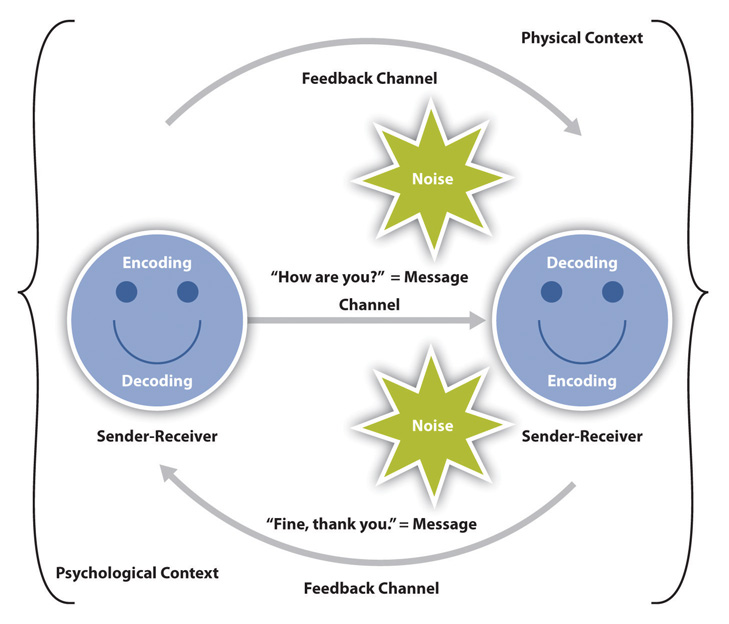Chapter 1
Chapter 1
Chapter 2
Chapter 3
Chapter 4
Chapter 5
Define Communication.
the deliberate or accidental creation of meaning
True or false: Self-concepts are easily changed over time.
False: Self-concepts are resistant to change. ■This tendency to seek and attend to information that conforms to an existing self-concept has been labeled cognitive conservatism.
What are the three points of I.A. Richards Semantic Triangle of meaning?
referent, thought, symbol
Which of the following is true:
nonverbal communication should be looked at separately with verbal communication.
nonverbal communication and verbal communication are opposites
nonverbal and verbal communication operate as a team together
Verbal communication is more important than nonverbal
nonverbal and verbal communication operate as a team together
What type of listening would be the best to utilize during a college lecture?
Informational
This form of communication is characteristically between an audience "too large to count"
Mass Communication
Define the 3 steps of the perception process? Give an example for each step
The first step in perception is the selection of which impressions we will attend to.
2nd step of the perception process where we sort & categorize information that we perceive based on innate and learned cognitive patterns.
Interpretation is the third part of the perception process, in which we assign meaning to our experiences using mental structures known as schemata.
What is the purpose of using the semantic triangle of meaning?
to help indicate the direct relationship of ideas to symbols
When Marissa gives direction she always talks with her hands; pointing as she explains where they need to go. This is an example of....?
Complementing, Accenting, Regulating, or Emphasizing
Complementing
Name 4 ways someone can show they are actively listening
paraphrasing, eye contact, asking questions, nodding their head. Showing they are engaged.
Draw on the board the interaction model of communication. And then... how does this model differ from the linear view model?
The interaction model shows communication as unidirectional. The linear model show communication as a one way street.

What happens often when we compare ourselves to others? (Give us one positive and one negative)
We describe and evaluate ourselves in comparison to others.
We may judge ourselves as more or less superior than other.
We decided what similarities and differences are more or less desirable in certain situations.
"You are insufferable and annoying. You need to clean this mess up" reword the statement to take more responsibility of the language used.
Ex: I think you need to clean this mess up. I feel very annoyed.
Gestures that do not need words to communicate meaning, such as a thumbs up or a frown, are what nonverbal function?
substituting
Describe an action oriented listener and give an example.
focused more on solving problems, over emotions. interested in finding out what the speaker wants. Ex: Betty is stressed about school and wants to vent. An action oriented listener will focus on the key things that may be going wrong and then may offer steps to find a solution.
Name at least 3 out of the 4 different types of noise in a communication setting. Give us an example of each.
1) External Noise: sounds, something visually distracting
2) Physiological Noise: the body is lacking something. Too hot, too cold, hungry, sleepy, etc
3) Psychological Noise: distractions presented from our mind. Ex: stress or worry
4) Semantic Noise: distractions presented by language choices. Ex: labels or stereotypes.
When Kasheem got caught speeding, Amy said that it definitely won't be his last ticket. The joke of Kasheem's fast driving was never let down, always repeated, and then sure enough a month later he gets another speeding ticket. What tendency is being described?
Self- Fulfilling Prophecy
What is an inference-observation confusion? And give an example of one
false conclusions based on thoughts or speculation perhaps leading to unnecessary action. Ex: Brad joked around about being late to his wedding, so just in case we need to tell him to arrive an hour early.
Name 3 examples of verbal or vocal nonverbal communication.
Define the 5 steps of the listening process with examples for each.
Hearing/receiving: During the hearing stage you are receiving stimuli or sounds. We can ignore stimuli or focus on them. Focusing on the teacher speaking
Interpreting: Decoding the information received. Student takes notes on the teacher lecture.
Recalling: We mentally save what we've gained from a speaker’s message for further use and make choices based on what’s worth remembering. Student remembering the answer for an exam.
Evaluating: We use critical thinking skills to weigh the worth of the speaker’s message, evaluating what we have heard and understood. The student makes judgment on what they have learned.
Responding: We can respond verbally and nonverbally. Student completes end of year class evaluation
What is a communication environment? Name the 5 major contexts to consider when evaluating a communication act?
Environments: fields of experience that affect how they understand others’ behavior.
•Social context: stated rules or unstated norms
•Relational context: history w/ others
•Cultural context
•Psychological context
•Physical context
What are the differences between someone's actual, ideal, and ought selves? Then... Have someone in your group define each of these as personal examples.
•The actual self consists of the attributes that you or someone else believes you possess.
•The ideal self consists of the attributes that you or someone else would like you to possess.
•The ought self consists of the attributes you or someone else believes you should possess.
What is a polysemic word? Give us two examples of polysemic words their meanings.
we should hang out "soon"
you are such a "rebel"
Chronemics is the study of time. Name 2 habits of a monochronic person. Then name 2 habits of a polychronic person.
monochronic: always being on time, being early, reaching deadlines
polychronic: showing up later, time is just a "suggestion"
Give constructive feedback for this 5 year old's drawing

Feedback should be
- Be specific
-Be descriptive
-Be positive
-Be constructive
-Be realistic
-Be relevant